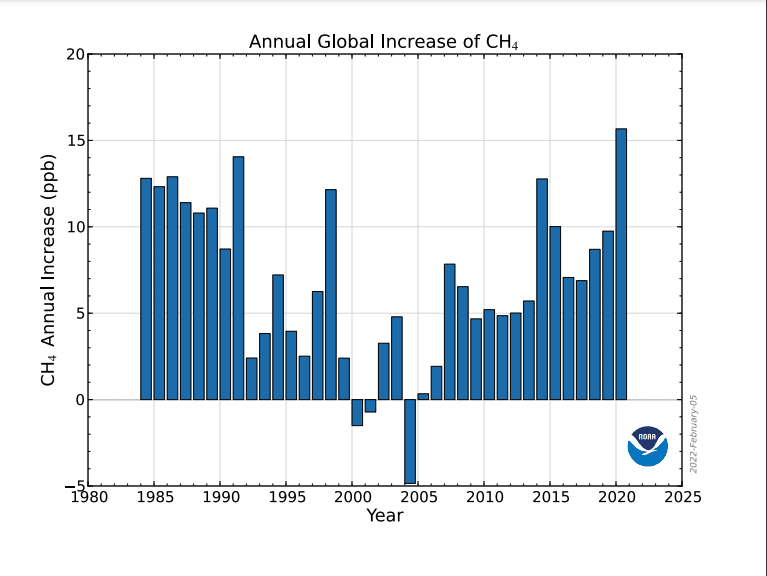Increased activity in wetlands and deliberate vents by oil and gas companies have caused methane concentration in the atmosphere to reach record levels.
—
Methane concentrations in the atmosphere have hit a record high of 1,900 parts per billion in 2021, a number that is nearly three times the pre-industrial levels, according to the US National Oceanic and Atmospheric Administration (NOAA).

“Methane levels are growing dangerously fast,” says Euan Nisbet, an Earth scientist at Royal Holloway, University of London, in Egham, UK, adding that this staggering trend is a major threat to limiting global temperature rise to 1.5-2C above pre-industrial levels.
Methane is a greenhouse gas that is at least 28 times as potent as carbon dioxide, and emissions have been worryingly on the rise since 2007, contributing towards and exacerbating the effects of climate change. The marked increase is evident by recent data released by NOAA in January, with some fearing that global warming is at risk of creating a feedback mechanism that will cause even more methane emissions released to the atmosphere.
You might also like: Why Limiting Methane Emissions Should be our Main Concern
Scientists have found it difficult to pin the causes and drivers of the methane spike. The biggest source of methane concentration increase today is from natural sources, specifically from wetlands, followed by fossil-fuel extraction, livestock, and landfill and agricultural waste. The working hypothesis is that global warming itself might be causing the increased productivity of microbes in tropical wetlands, and producing more methane gases as a result.
Separate satellite images also revealed that oil and gas companies routinely vent huge amounts of methane into the atmosphere. According to researchers with the Laboratory of Climate and Environmental Sciences in France, orbiting satellites detected more than 1,800 large bursts of methane over the course of 2019 and 200, with many occurrences releasing several tons of methane per hour. While some releases resulted from accidents, researchers found that in most cases, companies deliberately vent gas from pipelines or other equipment before carrying out repairs or maintenance operations. These detected emissions accounted for 8-12% of global methane emissions from oil and gas infrastructure during that period.
Climate experts agree that the fastest way to curb global warming in the short-term is to slash methane emissions. This culminated in the global methane pledge, where more than 100 countries – representing two-thirds of the global economy and half of the top 30 major methane emitting countries – have promised to cut collective methane emissions 30% from 2020 levels by 2030. Should the act be successful, lowered emissions are estimated to reduce global warming by at least 0.2C by 2050.


















